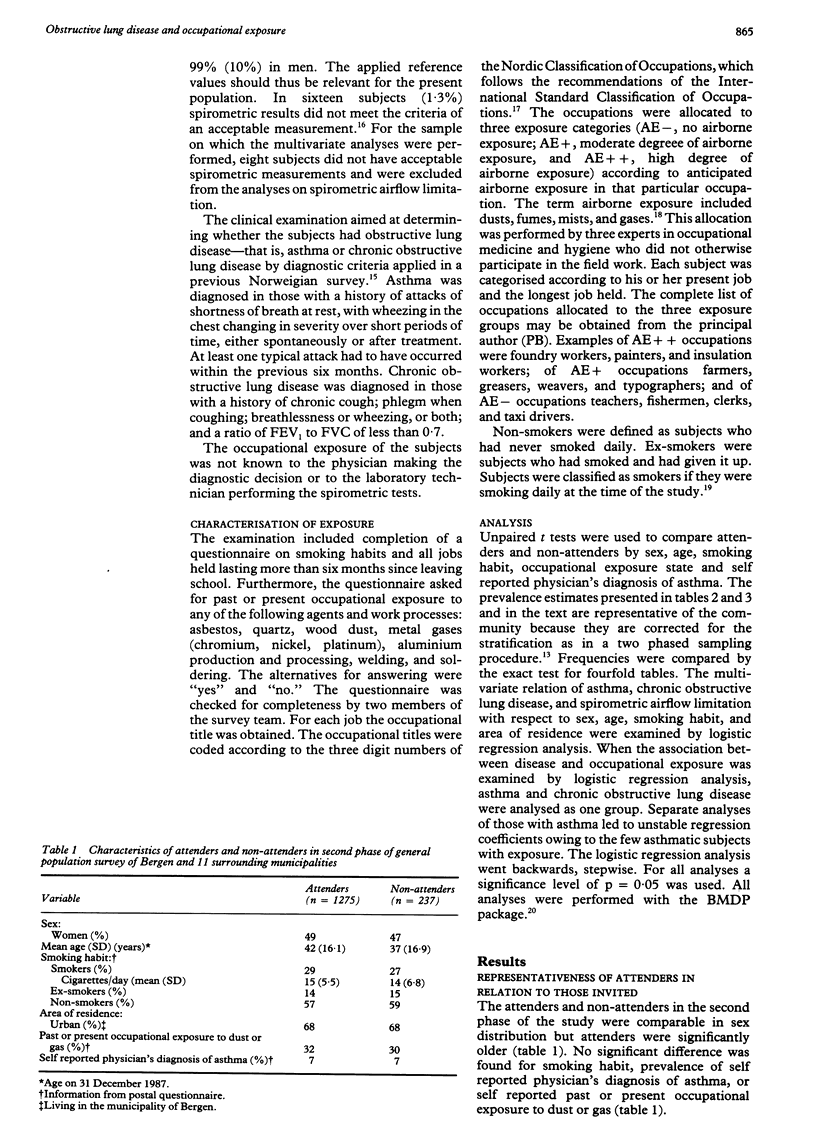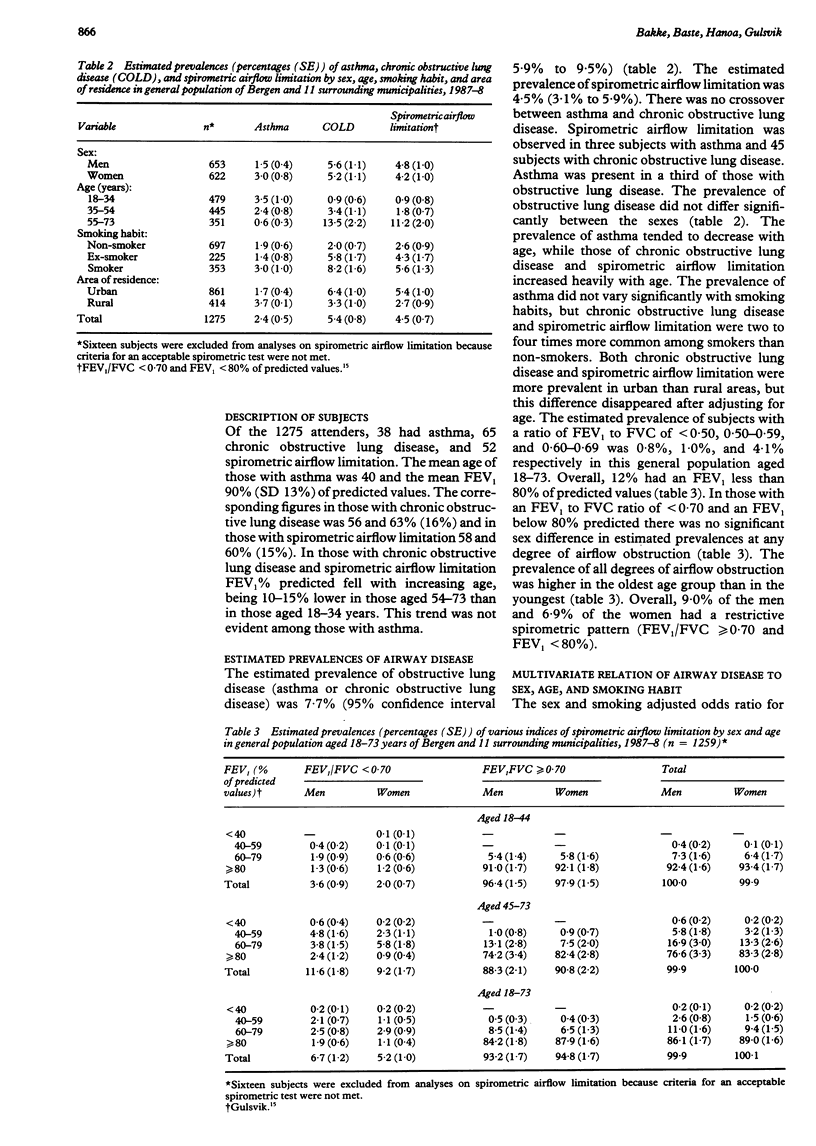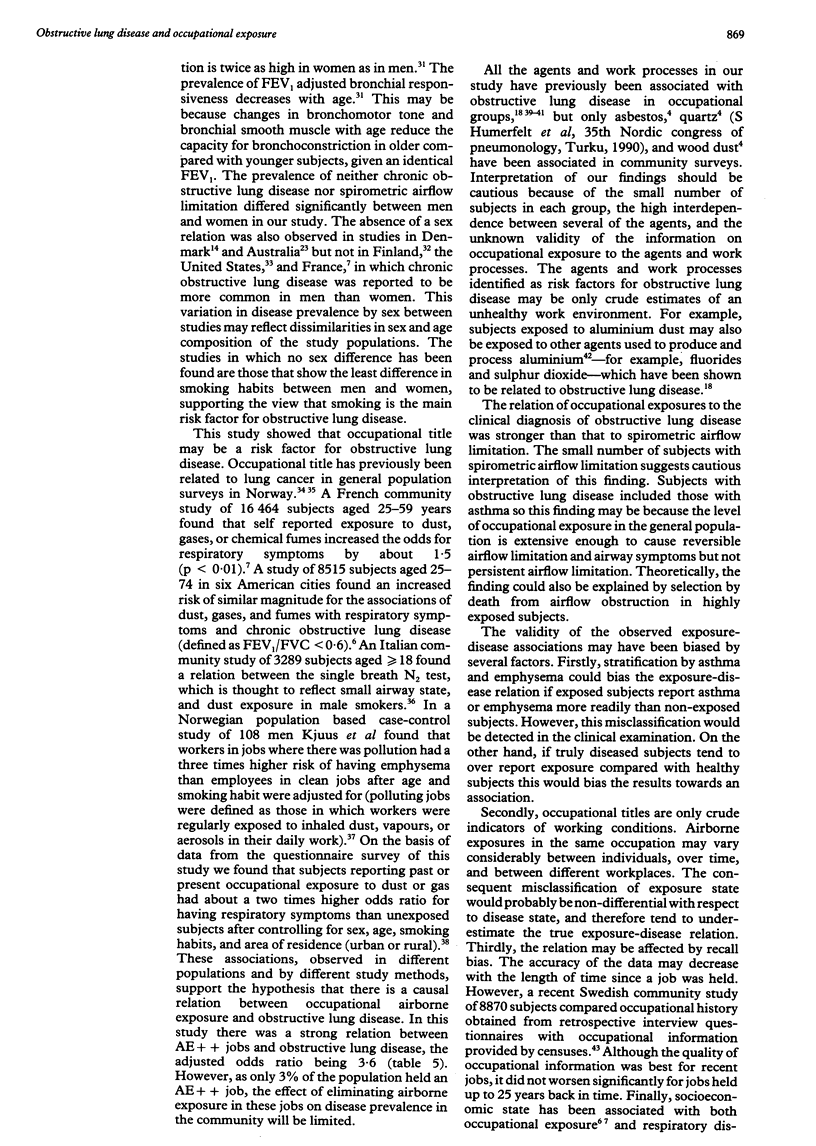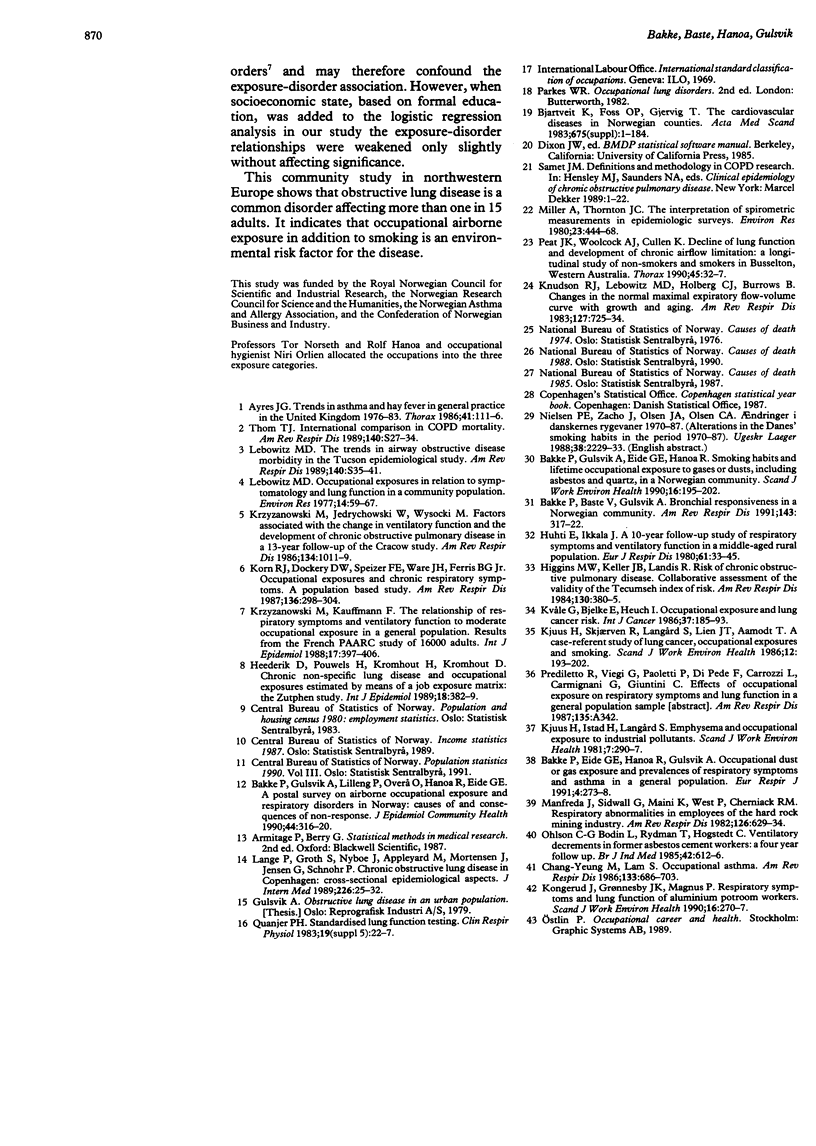Abstract
BACKGROUND: The importance of occupational exposure to airborne agents in the development of obstructive disease is uncertain. Studying the relation in a community population has the benefit of reducing the healthy worker effect seen in studies of working populations. METHODS: The prevalence of obstructive lung disease was examined in a Norwegian general population aged 18-73 in a two phased cross sectional survey. In the second phase a stratified sample (n = 1512) of those responding in the first phase was invited for clinical and spirometric examination (attendance rate 84%). Attenders were asked to state all jobs lasting greater than 6 months since leaving school and to say whether they had been exposed to any of seven specific agents and work processes potentially harmful to the lungs. RESULTS: The prevalence of asthma and chronic obstructive lung disease was 2.4% and 5.4%, respectively; spirometric airflow limitation (FEV1/FVC less than 0.7 and FEV1 less than 80% of predicted values) was observed in 4.5% of the population. All jobs were categorised into three groups according to the degree of potential airborne exposure. Having a job with a high degree of airborne exposure increased the sex, age, and smoking adjusted odds ratio for obstructive lung disease (asthma and chronic obstructive lung disease) by 3.6 (95% confidence interval 1.3 to 9.9) compared with having a job without airborne exposure; the association with spirometric airflow limitation was 1.4 (0.3 to 5.2). Occupational exposures to quartz, metal gases, aluminium production and processing, and welding were significantly associated with obstructive lung disease after adjusting for sex, age, and smoking habit, the adjusted odds ratios varying between 2.3 and 2.7. Occupational exposure to quartz and asbestos was significantly related to spirometric airflow limitation in people older than 50. CONCLUSION: Occupational title and exposure to specific agents and work processes may be independent markers of obstructive lung disease in the general population.
Full text
PDF







Selected References
These references are in PubMed. This may not be the complete list of references from this article.
- Ayres J. G. Trends in asthma and hay fever in general practice in the United Kingdom 1976-83. Thorax. 1986 Feb;41(2):111–116. doi: 10.1136/thx.41.2.111. [DOI] [PMC free article] [PubMed] [Google Scholar]
- Bakke P. S., Baste V., Gulsvik A. Bronchial responsiveness in a Norwegian community. Am Rev Respir Dis. 1991 Feb;143(2):317–322. doi: 10.1164/ajrccm/143.2.317. [DOI] [PubMed] [Google Scholar]
- Bakke P., Eide G. E., Hanoa R., Gulsvik A. Occupational dust or gas exposure and prevalences of respiratory symptoms and asthma in a general population. Eur Respir J. 1991 Mar;4(3):273–278. [PubMed] [Google Scholar]
- Bakke P., Gulsvik A., Eide G. E., Hanoa R. Smoking habits and lifetime occupational exposure to gases or dusts, including asbestos and quartz, in a Norwegian community. Scand J Work Environ Health. 1990 Jun;16(3):195–202. doi: 10.5271/sjweh.1794. [DOI] [PubMed] [Google Scholar]
- Bakke P., Gulsvik A., Lilleng P., Overå O., Hanoa R., Eide G. E. Postal survey on airborne occupational exposure and respiratory disorders in Norway: causes and consequences of non-response. J Epidemiol Community Health. 1990 Dec;44(4):316–320. doi: 10.1136/jech.44.4.316. [DOI] [PMC free article] [PubMed] [Google Scholar]
- Bjartveit K., Foss O. P., Gjervig T. The cardiovascular disease study in Norwegian counties. Results from first screening. Acta Med Scand Suppl. 1983;675:1–184. [PubMed] [Google Scholar]
- Chan-Yeung M., Lam S. Occupational asthma. Am Rev Respir Dis. 1986 Apr;133(4):686–703. doi: 10.1164/arrd.1986.133.4.686. [DOI] [PubMed] [Google Scholar]
- Heederik D., Pouwels H., Kromhout H., Kromhout D. Chronic non-specific lung disease and occupational exposures estimated by means of a job exposure matrix: the Zutphen Study. Int J Epidemiol. 1989 Jun;18(2):382–389. doi: 10.1093/ije/18.2.382. [DOI] [PubMed] [Google Scholar]
- Higgins M. W., Keller J. B., Landis J. R., Beaty T. H., Burrows B., Demets D., Diem J. E., Higgins I. T., Lakatos E., Lebowitz M. D. Risk of chronic obstructive pulmonary disease. Collaborative assessment of the validity of the Tecumseh index of risk. Am Rev Respir Dis. 1984 Sep;130(3):380–385. doi: 10.1164/arrd.1984.130.3.380. [DOI] [PubMed] [Google Scholar]
- Kjuus H., Istad H., Langård S. Emphysema and occupational exposure to industrial pollutants. Scand J Work Environ Health. 1981 Dec;7(4):290–297. doi: 10.5271/sjweh.2545. [DOI] [PubMed] [Google Scholar]
- Kjuus H., Skjaerven R., Langård S., Lien J. T., Aamodt T. A case-referent study of lung cancer, occupational exposures and smoking. I. Comparison of title-based and exposure-based occupational information. Scand J Work Environ Health. 1986 Jun;12(3):193–202. doi: 10.5271/sjweh.2158. [DOI] [PubMed] [Google Scholar]
- Knudson R. J., Lebowitz M. D., Holberg C. J., Burrows B. Changes in the normal maximal expiratory flow-volume curve with growth and aging. Am Rev Respir Dis. 1983 Jun;127(6):725–734. doi: 10.1164/arrd.1983.127.6.725. [DOI] [PubMed] [Google Scholar]
- Kongerud J., Grønnesby J. K., Magnus P. Respiratory symptoms and lung function of aluminum potroom workers. Scand J Work Environ Health. 1990 Aug;16(4):270–277. doi: 10.5271/sjweh.1785. [DOI] [PubMed] [Google Scholar]
- Korn R. J., Dockery D. W., Speizer F. E., Ware J. H., Ferris B. G., Jr Occupational exposures and chronic respiratory symptoms. A population-based study. Am Rev Respir Dis. 1987 Aug;136(2):298–304. doi: 10.1164/ajrccm/136.2.298. [DOI] [PubMed] [Google Scholar]
- Krzyzanowski M., Jedrychowski W., Wysocki M. Factors associated with the change in ventilatory function and the development of chronic obstructive pulmonary disease in a 13-year follow-up of the Cracow Study. Risk of chronic obstructive pulmonary disease. Am Rev Respir Dis. 1986 Nov;134(5):1011–1019. doi: 10.1164/arrd.1986.134.5.1011. [DOI] [PubMed] [Google Scholar]
- Krzyzanowski M., Kauffmann F. The relation of respiratory symptoms and ventilatory function to moderate occupational exposure in a general population. Results from the French PAARC study of 16,000 adults. Int J Epidemiol. 1988 Jun;17(2):397–406. doi: 10.1093/ije/17.2.397. [DOI] [PubMed] [Google Scholar]
- Kvåle G., Bjelke E., Heuch I. Occupational exposure and lung cancer risk. Int J Cancer. 1986 Feb 15;37(2):185–193. doi: 10.1002/ijc.2910370204. [DOI] [PubMed] [Google Scholar]
- Lange P., Groth S., Nyboe J., Appleyard M., Mortensen J., Jensen G., Schnohr P. Chronic obstructive lung disease in Copenhagen: cross-sectional epidemiological aspects. J Intern Med. 1989 Jul;226(1):25–32. doi: 10.1111/j.1365-2796.1989.tb01349.x. [DOI] [PubMed] [Google Scholar]
- Lebowitz M. D. Occupational exposures in relation to symptomatology and lung function in a community population. Environ Res. 1977 Aug;14(1):59–67. doi: 10.1016/0013-9351(77)90066-4. [DOI] [PubMed] [Google Scholar]
- Lebowitz M. D. The trends in airway obstructive disease morbidity in the Tucson Epidemiological Study. Am Rev Respir Dis. 1989 Sep;140(3 Pt 2):S35–S41. doi: 10.1164/ajrccm/140.3_Pt_2.S35. [DOI] [PubMed] [Google Scholar]
- Manfreda J., Sidwall G., Maini K., West P., Cherniack R. M. Respiratory abnormalities in employees of the hard rock mining industry. Am Rev Respir Dis. 1982 Oct;126(4):629–634. doi: 10.1164/arrd.1982.126.4.629. [DOI] [PubMed] [Google Scholar]
- Miller A., Thornton J. C. The interpretation of spirometric measurements in epidemiologic surveys. Environ Res. 1980 Dec;23(2):444–468. doi: 10.1016/0013-9351(80)90078-x. [DOI] [PubMed] [Google Scholar]
- Nielsen P. E., Zacho J., Olsen J. A., Olsen C. A. Aendringer i danskernes rygevaner 1970-1987. Ugeskr Laeger. 1988 Sep 19;150(38):2229–2233. [PubMed] [Google Scholar]
- Ohlson C. G., Bodin L., Rydman T., Hogstedt C. Ventilatory decrements in former asbestos cement workers: a four year follow up. Br J Ind Med. 1985 Sep;42(9):612–616. doi: 10.1136/oem.42.9.612. [DOI] [PMC free article] [PubMed] [Google Scholar]
- Peat J. K., Woolcock A. J., Cullen K. Decline of lung function and development of chronic airflow limitation: a longitudinal study of non-smokers and smokers in Busselton, Western Australia. Thorax. 1990 Jan;45(1):32–37. doi: 10.1136/thx.45.1.32. [DOI] [PMC free article] [PubMed] [Google Scholar]
- Thom T. J. International comparisons in COPD mortality. Am Rev Respir Dis. 1989 Sep;140(3 Pt 2):S27–S34. doi: 10.1164/ajrccm/140.3_Pt_2.S27. [DOI] [PubMed] [Google Scholar]


